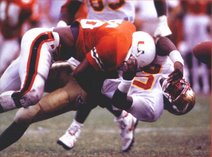Written By: Nathan Skinner & Kartik Krishnaiyer
Canes Rising Contributors
Editors Note: Elements of this article were first published on Canes Rising back in 2008.
In today's college football world, the name of the game is offense. Most modern offenses depend on a balanced mix of run and pass, with some offenses going to extremes. The air raid, the run and shoot, and the fun and gun are all pass heavy offenses that are seen in the college game. However, there's a few run heavy offenses left including the ultimate survivor, the flexbone. It's an offense that harkens back to a bygone era, an era i,n which the pass was something exotic, something that was a sign of desperation.
What is the Flexbone?
| The Flexbone Formation |
The flexbone is a derivative of the wishbone formation. The wishbone formation was invented in the late 60s by Texas assistant coach Emory Bellard. The wishbone spread to other programs after Texas used the innovative offense to secure 2 consecutive national championships. Eventually, as defenses adjusted and the offense started to struggle, teams searched for a way to update the formation. What was once the wishbone, became the flexbone once the tailbacks were split out to shadow the offensive tackles. In the flexbone, the tight ends are eliminated, and replaced with wide receivers. The flexing allows the backs to get out into the open field a little easier, and it also forces defenses to defend more of the field, instead of overloading the box.
 |
| The Wishbone Formation |
In the flexbone, the A-Backs are usually placed in motion, to create confusion, and to force the defense to adjust. The A-Backs are the slotbacks, and are the most dynamic players on the field. A-Backs can be used as traditional running backs, option backs, or as receivers in passing situations. The prototypical A-Back is a quick, small running back who can also be a receiver and isn't afraid to block. The fullback, also known as the B-Back is a key part of the formation. The B-Back is usually the player asked to be the dive option on the option, or a lead blocker for the A-Backs. The fullback can also be used as a decoy in order to facilitate perimeter runs. A prototypical B-Back is a physical inside runner with a nose for contact.
The flexbone requires a different breed of quarterback. In most modern offenses, quarterbacks are expected to be talented passers who can make complex pre-snap reads.That's not how the flexbone works, it's almost the exact opposite. The typical flexbone quarterback makes most of his reads after the snap, especially on option plays. On an option play, the quarterback has to decide whether he will hand to the B-Back up the middle, pitch the ball to one of the A-Backs on the perimeter, or keep the football himself. The decision is made off of keys which have to be recognized within milliseconds of the snap. Flexbone quarterbacks are rarely asked to pass and when they do are asked to make simple passes, to receivers running rudimentary routes. As a result, most flexbone quarterbacks are talented athletes who are limited passers.
This formation also affects the offensive line. Because of the reliance on the triple option, the O-Line relies on an endless array of cut blocks instead of conventional blocking schemes. Because of the option game, flexbone offensive linemen tend to be smaller than than average, with great mobility. This is a major reason why fans see the flexbone at the service academies. Due to Department of Defense regulations, the service academies can't recruit overly large student athletes.
How can you stop it?
The flexbone is an offense based on precision, and movement. To stop it, certain things must happen, and they have to happen all of the time.
1. Interior defensive linemen have to stop the B-Back--The key to stopping the option is eliminating as many options as possible. The D-Line has to find a way to defeat cut blocks, and clog the point of attack on dive plays. If a flexbone team can't count on the dive, the perimeter runs are less potent.
2. Linebackers have to diagnose plays, and tackle--The linebackers have to recognize the dive, or an outside option, and flow to the football. It's also important for the linebackers to maintain their assignments. It's also imperative for the 'backers, and every defensive player to tackle well. Hidden yards prevent these offenses from facing obvious passing situations.
3. Secondary has to maintain leverage on receivers--The secondary can't be caught "peeking" into the backfield, because that can lead to open receivers on playaction plays. The secondary has to be active in the run game, defeating the blocks of the receivers and making tackles around the line of scrimmage. The safeties are likely to be in the box, which means they have to make sure they are free to run to the football. They cannot allow an offensive lineman to engage them.





